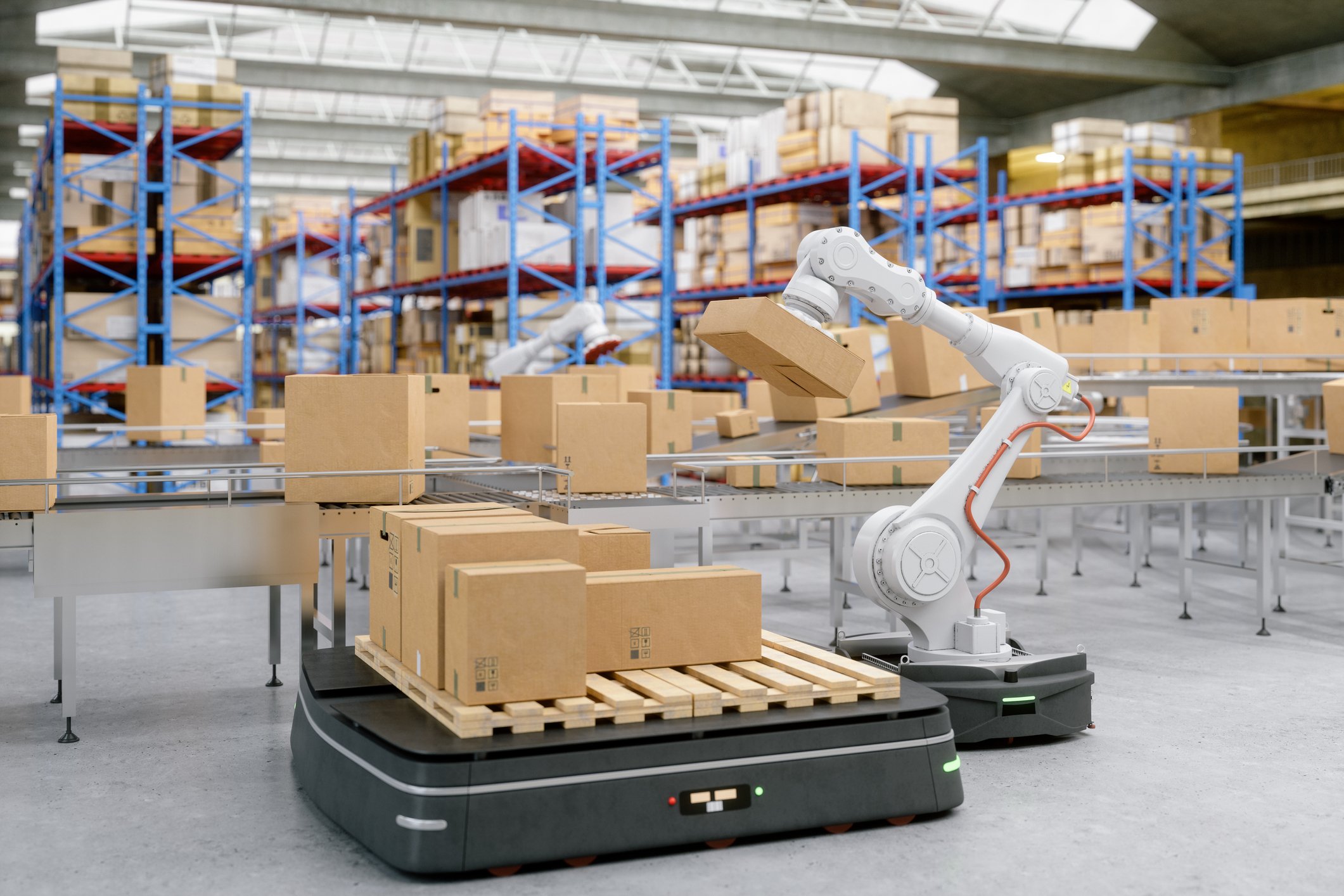The robotics revolution isn't coming in a decade. It's arriving within the next three years.
While investors debate humanoid robots and artificial general intelligence (AGI), a more immediate transformation is unfolding in warehouses across America. Labor shortages have reached crisis levels, with unfilled logistics positions doubling since 2020.

Image source: Getty Images.
E-commerce complexity has exploded, with consumers expecting two-day delivery on millions of stock-keeping units (SKUs). And artificial intelligence (AI) has reached the sophistication needed to orchestrate autonomous operations on a massive scale.
One company stands at the epicenter of this transformation, turning warehouse chaos into algorithmic efficiency, while generating real revenue growth that makes speculative robotics plays look like yesterday's news.
The warehouse automation juggernaut
Symbotic (SYM +5.78%) brings AI-powered robotics to a $25 billion problem: warehouse inefficiency. The $28 billion company posted $550 million in Q2 fiscal 2025 revenue, up 40% year over year, while improving adjusted earnings before interest, taxes, depreciation, and amortization (EBITDA) to $35 million from $9 million.

NASDAQ: SYM
Key Data Points
Unlike speculative robotics plays, Symbotic serves blue chip customers today. The company's acquisition of Walmart's (WMT 0.12%) Advanced Systems and Robotics business, completed in Q1 fiscal 2025, deepens a relationship with the world's largest retailer. When Walmart sold its internal robotics division to Symbotic, it validated both the technology's superiority and the partnership's strategic importance.
Where humans fear to tread
Traditional warehouses represent the last frontier of manual labor in the supply chain. While manufacturing automated decades ago, distribution centers still rely on humans walking miles per day, lifting heavy boxes, and working in environments that range from freezing to sweltering. The average warehouse worker walks 12 to 15 miles per shift -- a physically demanding job that few people want.
Symbotic's AI-powered robots don't just replace human pickers. The company reimagines the entire warehouse as an integrated system where robots handle storage, retrieval, and sorting with superhuman efficiency. Products move through Symbotic warehouses five to 10 times faster than traditional facilities, with 99.9% accuracy rates that eliminate costly shipping errors.
The technology creates a network effect. As Symbotic deploys more systems, its AI learns from billions of picks across different environments, continuously improving performance. Each new installation makes the next one better -- a compounding advantage competitors can't match without similar scale.
The path to a $100 billion market
The warehouse automation market stands at $25 billion today, with credible projections showing it reaching $85 billion to $110 billion by the mid-2030s. This represents a 3.5x to 4.5x growth opportunity over the next decade.
This expansion is driven by concrete factors. First, e-commerce penetration continues to grow, requiring more sophisticated fulfillment infrastructure. Second, the current automation penetration rate in warehouses remains below 5% globally, with industry analysts projecting this could reach 15% to 20% by 2035.
Major market research firms, including Precedence Research and Grand View Research, project the market will grow at 15% to 18% annually through 2034. This steady growth reflects both the massive opportunity and the practical constraints of deploying complex automation systems at scale.
Symbotic is well-positioned to capitalize on this expanding market. Its existing partnerships with industry leaders like Albertsons and C&S Wholesale Grocers, along with a firm backlog of nearly $23 billion, provide a strong foundation for capturing future growth.
The company's expansion strategy within existing accounts offers additional runway. Once retailers achieve 30% to 50% reductions in operating costs, automation typically spreads from pilot facilities to entire networks. With Walmart operating over 200 distribution centers in North America and Symbotic deployed in a fraction of them, the growth potential within current customers alone remains substantial.
Reality check on robotics
Symbotic faces legitimate challenges. System deployments require 18 to 24 months from contract to full operation, creating lumpy revenue recognition. The technology works best in high-volume facilities with predictable SKU mixes -- limiting applicability to smaller operations. Competition from established players like Amazon subsidiary Kiva Systems and start-ups flush with venture capital intensifies quarterly.
But these concerns pale against the fundamental labor crisis facing logistics. The American Trucking Association reports 80,000 unfilled driver positions, and warehouses face increasingly alarming turnover rates. Wage inflation in logistics outpaces every other sector, and automation becomes essential for business continuity when human workers simply can't be found.
The warehouse automation window
For investors seeking robotics exposure, Symbotic scans as a compelling vehicle. The company generates real revenue from solving immediate business problems, and its technology delivers proven return on investment (ROI) that CFOs can model. Most importantly, Symbotic operates in a market where automation represents survival, not speculation.
The robotics revolution arrives in waves. Warehouses automate first because the economics are irresistible. Manufacturing follows, as collaborative robots become more sophisticated, and eventually, humanoid robots may handle complex consumer-facing tasks. But investors need not wait for that distant future.
Symbotic brings the robotics revolution to market today, with the revenue growth and customer validation to prove it. In a sector filled with promises, profits matter more than potential.
For investors ready to capitalize on the automation imperative, the opportunity won't last long. The robots are already at work. The only question is whether your portfolio will benefit.






